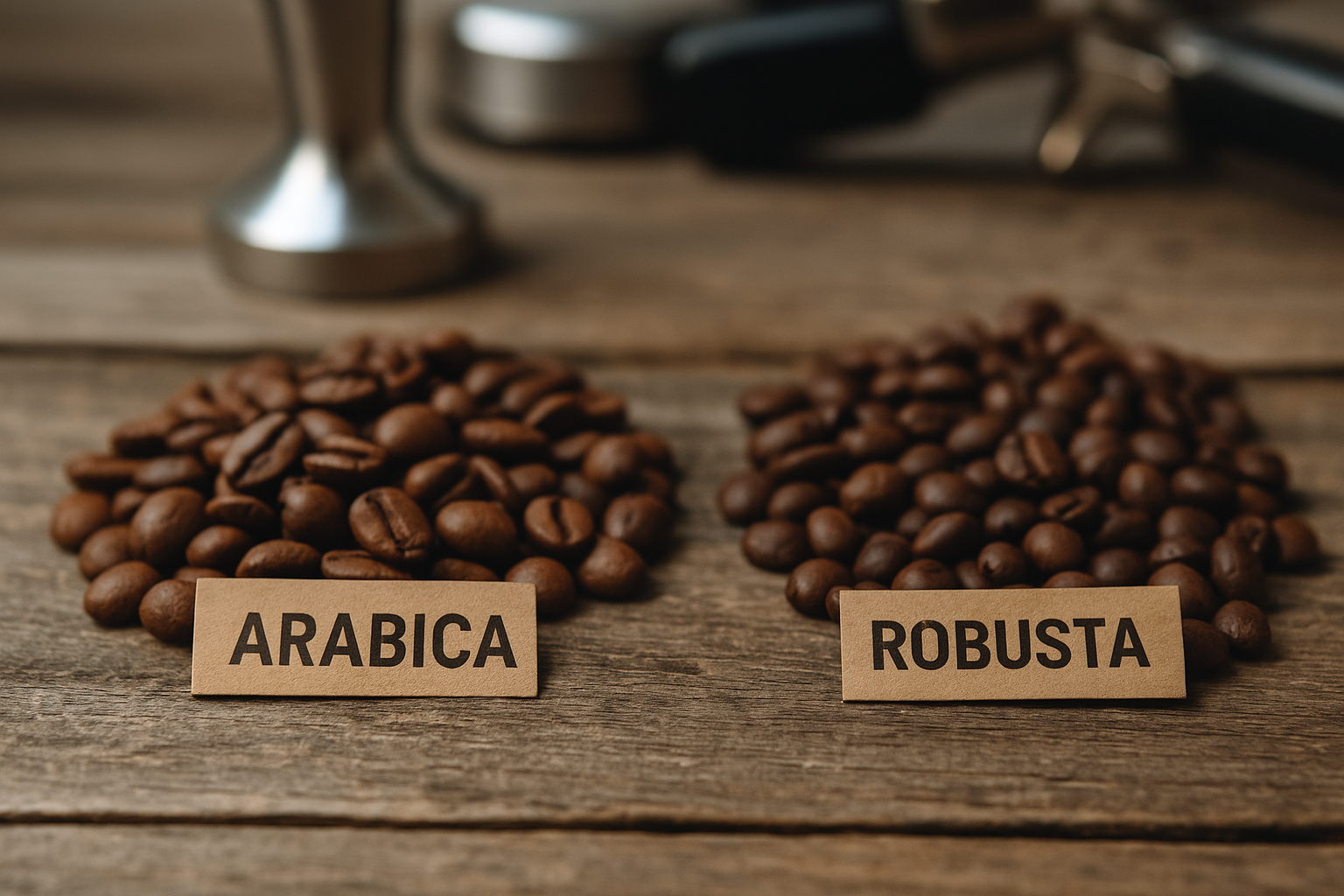If you’re serious about becoming a skilled barista, one of the most important things to understand is the difference between Coffea arabica and Coffea canephora, commonly known as Arabica and Robusta.
These two species dominate global coffee production, but they are far from identical. From their growing conditions to their flavor profiles and economic roles, each has unique traits that affect how a barista works with them.
Understanding Arabica and Robusta isn’t just useful trivia — it’s essential to your day-to-day work.
Whether you’re choosing beans for espresso or adjusting grind size to balance bitterness, your knowledge of coffee species can influence flavor, efficiency, and customer satisfaction.
Origins and Growing Conditions
Arabica is the older of the two species and originated in the highlands of Ethiopia. It thrives at higher altitudes, typically between 1,000 and 2,000 meters, in cooler climates with consistent rainfall.
These conditions create slower-growing plants, which in turn develop more complex sugars and flavors.
Robusta, on the other hand, is native to Central and Western sub-Saharan Africa. It grows well at lower altitudes and is more tolerant of heat, humidity, and disease.
This makes it easier and cheaper to cultivate, particularly in regions like Vietnam, Brazil, and parts of Indonesia.
As a barista, it’s important to note that a bean’s growing environment directly influences the roast profile and brewing method.
Arabica beans, with their higher acidity and nuanced flavors, are often roasted lighter to preserve complexity. Robusta, with its bold and earthy characteristics, is frequently roasted darker to tame bitterness and enhance body.
Flavor Profile: A Barista’s Sensory Guide
The most noticeable difference between Arabica and Robusta is their flavor. Arabica beans tend to have a wider taste range: they can be floral, fruity, nutty, chocolatey, or even tea-like.
Their acidity gives them brightness, which is often described as citrusy or wine-like. The mouthfeel is typically lighter and more delicate.
Robusta, in contrast, delivers a strong, bold flavor. It often carries earthy, woody, or even rubbery notes. It’s less acidic but has a heavier body and more bitterness.
Some describe it as having a “burnt toast” or “peanut shell” taste — not always pleasant when used on its own, but very useful when balanced correctly in a blend.
If you’re dialing in an espresso, the type of bean matters immensely. Arabica usually results in a smoother, more aromatic shot, while Robusta adds crema and caffeine punch. Blends containing Robusta are common in traditional Italian espresso for this reason.
Caffeine Content and Crema Production
One of Robusta’s most famous features is its high caffeine content. Robusta beans contain almost twice the caffeine of Arabica. This makes them not only more energizing but also more bitter.
The higher caffeine and lipid content also contribute to one of the most beloved elements in espresso: crema.
Robusta beans are excellent for crema production, which is why many espresso blends contain at least 10–30% Robusta. The thick, golden-brown crema is not just visually appealing — it adds texture and aroma to the cup.
However, caffeine isn’t everything. Too much Robusta can overpower the subtle complexities that many specialty coffee drinkers appreciate. As a barista, striking the right balance in blends is both a technical and creative skill.
Price and Market Considerations
Arabica is generally more expensive to grow and buy. It’s more delicate, more prone to disease, and requires specific altitude and climate conditions.
These factors contribute to a higher retail price and a perception of quality in the specialty coffee world.
Robusta is more resistant to pests and easier to produce on a large scale. It’s often used in instant coffee, supermarket blends, and economy espresso.
However, this doesn’t mean Robusta has no place in specialty coffee. High-quality Robusta exists, and more producers are experimenting with careful cultivation and processing to elevate its profile.
Baristas working in cafés with price-sensitive clientele may find themselves using blends that include Robusta. Knowing how to balance and highlight its characteristics can set you apart in terms of skill and understanding.
Processing Differences
Arabica beans are most often washed (wet processed) to bring out their clean, acidic notes. Some are naturally processed or honey-processed for sweeter, fruitier tones. These methods require more labor and care, which again raises the final cost.
Robusta is frequently dry processed, especially in regions where water is scarce. The drying process tends to amplify its earthy flavors and bitterness.
However, some producers are beginning to apply fermentation or more experimental methods to Robusta to create smoother, more refined profiles.
For baristas, this means you can’t just judge a coffee by species alone — processing has a massive impact. Two Arabica beans processed differently can taste more distinct than Arabica vs Robusta.
Environmental and Ethical Considerations
Arabica’s sensitivity to climate change is becoming a major concern in the coffee industry. As global temperatures rise, Arabica yields are declining in many traditional regions.
This has led to an increased interest in Robusta, which is more climate-resilient.
That said, the environmental impact of coffee cultivation varies widely depending on farming practices.
Whether you’re using Arabica or Robusta, look for beans that are certified organic, shade-grown, or fair trade, whenever possible. As a barista, you can play a role in promoting ethical sourcing by asking roasters about their supply chains and sharing that knowledge with customers.
Common Uses in the Coffee World
Arabica is the star in most specialty cafés, single-origin offerings, and manual brews like pour-overs, AeroPress, and Chemex. It’s favored for its complexity, clarity, and overall drinking experience.
Robusta, while often relegated to mass-market blends and instant coffee, plays a critical role in espresso culture. Traditional Italian espresso, Vietnamese cà phê sữa đá, and many dark-roast blends wouldn’t exist without it.
In competitions and high-end cafés, 100% Arabica is still the standard. But some forward-thinking baristas are reintroducing Robusta in innovative ways, highlighting the diversity of the species.
Tips for Baristas: Working With Each Bean
When preparing Arabica:
- Use lower brewing temperatures (90–94°C) to preserve acidity.
- Opt for medium to light roasts to keep flavor clarity.
- Grind slightly coarser for pour-overs to highlight brightness.
When preparing Robusta:
- Use higher brewing temperatures (94–96°C) to balance bitterness.
- Blend with Arabica for more crema and body in espresso.
- Experiment with milk drinks where bitterness can shine through.
Knowing how to adjust your technique for each species will make you a more flexible and confident barista. It’s not just about following recipes — it’s about understanding what’s in the bean and what your tools can do with it.
Final Thoughts: Respecting the Role of Both Species
Arabica and Robusta are different, but not in a way that makes one inherently better than the other. Each serves a purpose in the global coffee scene, and both deserve respect and understanding.
As a barista, your job isn’t just to make drinks — it’s to educate, inspire, and connect people through coffee. Knowing your beans is the foundation for doing that well.
So the next time you weigh a dose, steam milk, or chat with a curious customer, remember: you’re not just working with coffee. You’re working with two stories, two plants, and two worlds of possibility.

Artur is a coffee enthusiast and content creator passionate about barista techniques and coffee culture. With a sharp eye for detail and a love for learning, he shares practical tips, brewing guides, and gear insights to help readers elevate their coffee experience — from home brewers to aspiring professionals.
